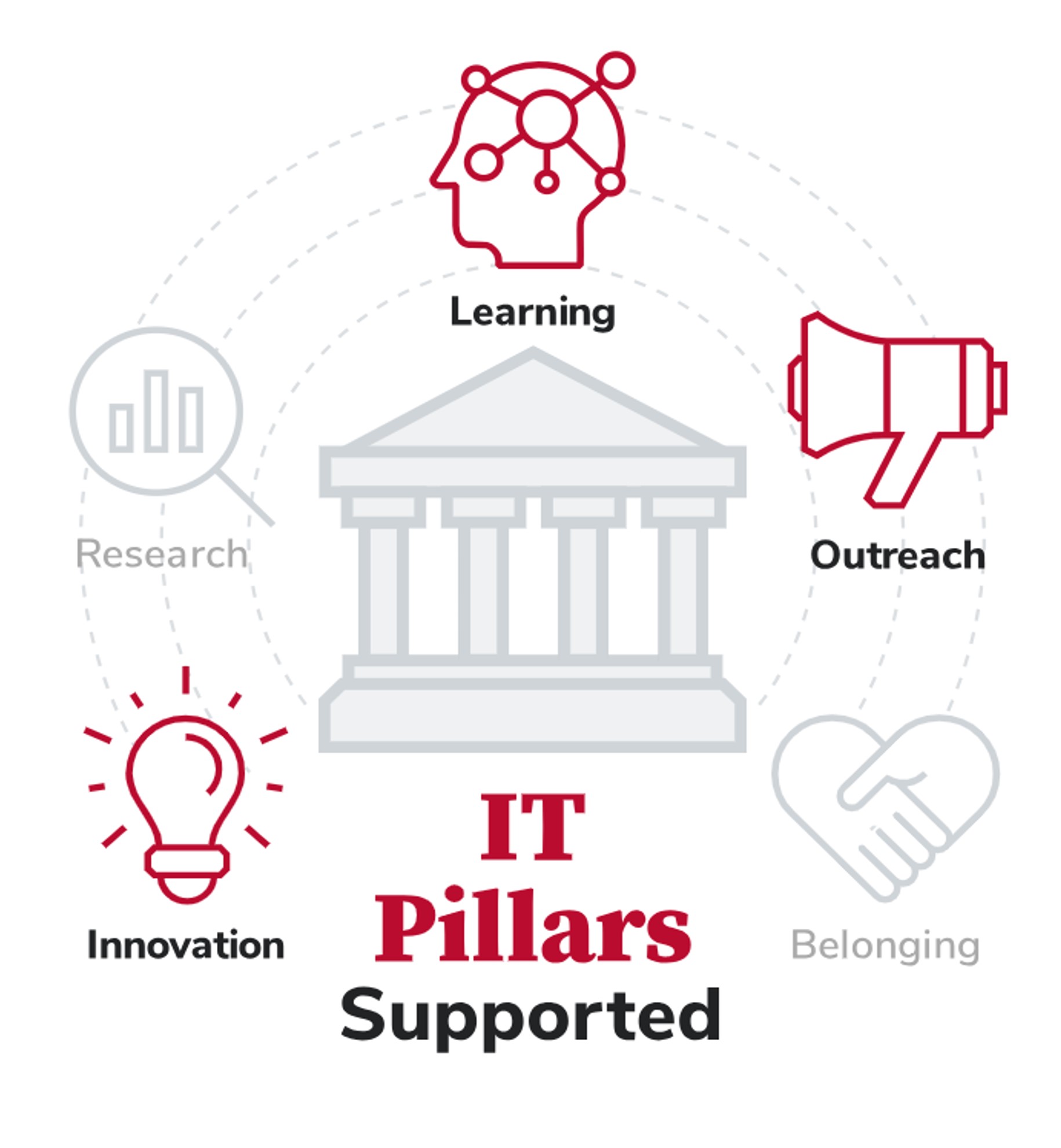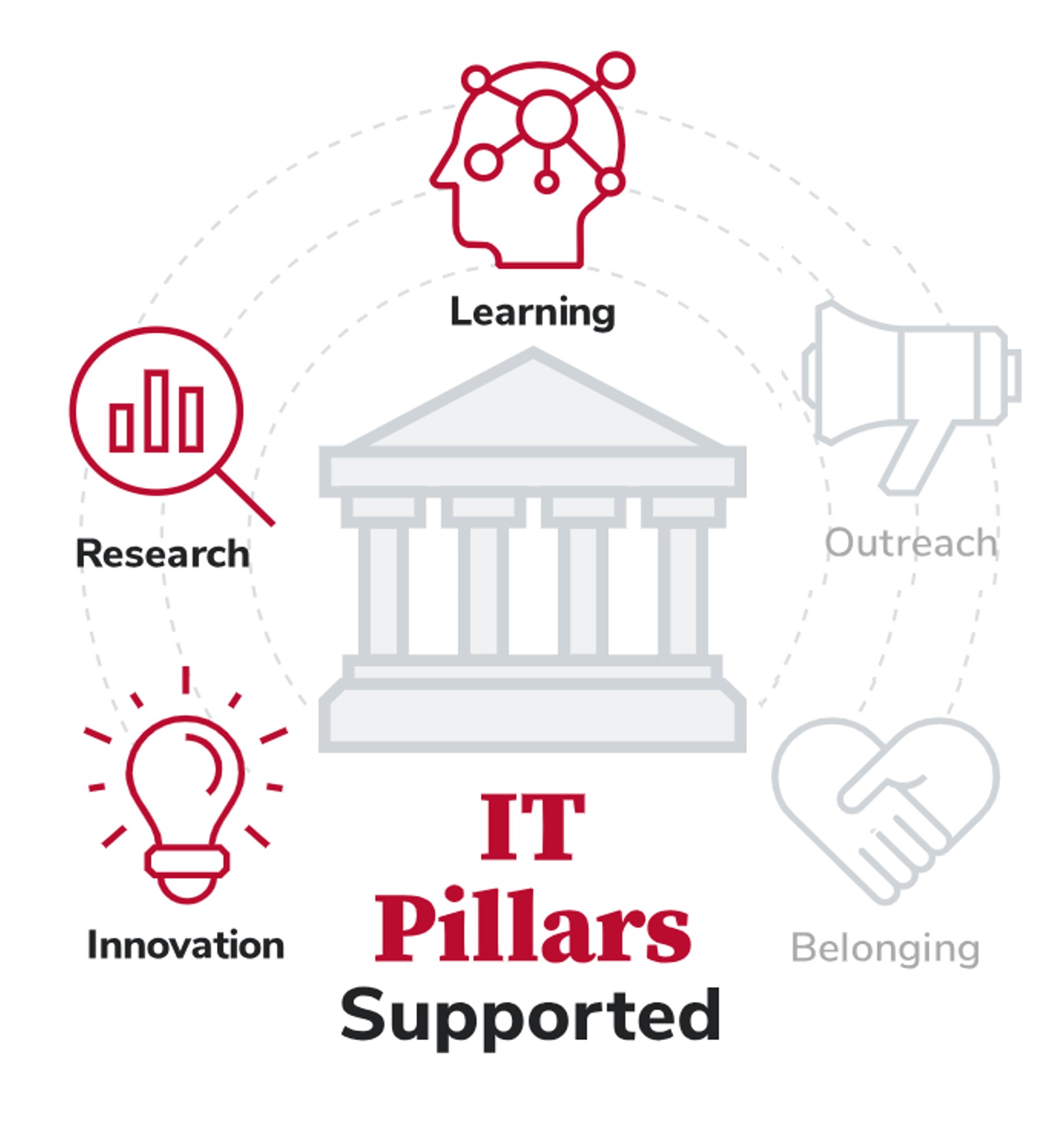Key Initiatives
At any given time, hundreds of projects and initiatives are happening within OTDI to maintain, enhance, or implement technology services that will benefit teaching, learning, research, and outreach at the university. Each year, a handful of projects are identified with the most significant impact or criticality.
Below is our current list of top projects and strategic priorities. This list is a living document, as technology and priorities can change quickly.
Assess Storage Solutions
The Storage Strategy Working Group is developing a comprehensive plan to align our storage investments with the university’s diverse needs, from research and teaching to administrative requirements. By streamlining storage options and identifying the best on-premise and cloud solutions, we aim to enhance user experience, improve compliance, and reduce costs through collaboration. This initiative will make it easier for faculty, students, and staff to find and use the right storage solutions for their needs, while also ensuring Ohio State’s data is secure and accessible across the university. Timeline: Fall 2024 – TBD
Deploy New Library System
Ohio State’s Libraries catalog and discovery services are migrating to a modern, integrated, industry-standard solution and will benefit research, teaching, and outreach efforts in collaboration with OhioLINK. Ohio State will enjoy expanded functionality and easier sharing of resources, supporting student learning and faculty scholarly activities. This upgrade aligns with the university’s academic mission by ensuring students and researchers can access critical information and materials seamlessly. While the project and its major activities fall under University Libraries’ portfolio, OTDI is providing project management, identity and access tools, and regional technical support.
Empower Ohio State Online
Our partnership with Ohio State Online enables us to support the growing demand for digital education. Through close collaboration, we ensure that online students—whether balancing work, family, or military commitments—have a seamless and efficient learning experience. Our efforts in streamlining system updates, troubleshooting, and feature enhancements simplify the online learning process, making education accessible to all types of students. This work supports lifelong learners and traditional students alike by providing the tools and resources they need to succeed. Timeline: Ongoing
Enhance Service Management
We are improving our service management system in collaboration with the Wexner Medical Center to better support academic and operational excellence. By aligning service management tools and workflows, we will enhance collaboration across departments, speeding up issue resolution and improving customer service. These enhancements will reduce costs and make it easier for faculty, staff, and students to connect with technical support, ensuring smoother operations in support of Ohio State’s teaching and research missions. Timeline: Fall 2024 – TBD
Enrich Classroom Accessibility
Our Learning and Collaborative Environments team is working to enhance accessibility and technology in classrooms across the university. We are piloting solutions that allow students to use personal devices to improve audio experiences in large lecture halls, ensuring that all students and faculty, including those with disabilities, have an equitable learning experience. By expanding collaboration with Student Life Disability Services, we are creating more inclusive and innovative learning spaces, aligning with Ohio State’s commitment to equitable education. Timeline: Fall 2024 – Spring 2025
Expand Shared Directory and Endpoint Service Footprint
The Shared Active Directory and Endpoint Services program is streamlining IT services across Ohio State’s colleges and departments. This project will standardize IT experiences, enhance collaboration, and provide consistent access to university resources regardless of location. By reducing redundancies and enabling easier access to tools like Microsoft 365, we are supporting interdisciplinary research and teaching while improving operational efficiency. This initiative will simplify IT management and enhance user experiences across the university. Timeline: June 2021 – TBD (Estimate: 2031)
Implement Microsoft Email and Storage Changes
In response to Microsoft’s contract changes, we are adjusting our email and storage systems to minimize financial impact while maintaining essential services. These changes include reducing storage allocations and modifying license features. By working closely with stakeholders, we aim to provide cost-effective solutions that ensure continued access to key communication and collaboration tools, such as OneDrive and Teams. This initiative aligns with our goal of supporting operational excellence while managing costs efficiently. Timeline: February 2024 – June 2026
Improve Learning Technologies
Improving learning technologies with enhance the educational experience at Ohio State through a strategy that includes adopting innovative solutions, improving accessibility, and ensuring tools are aligned with the university's mission to create inclusive, high-quality learning environments. The initiative also seeks to streamline processes, reduce costs, and clarify roles. Key outcomes include enhancing accessibility by 2026, simplifying learning experiences, and improving efficiency across different teaching modalities. These efforts will benefit faculty, students, and staff, ensuring a more cohesive and accessible educational experience while aligning with Ohio State’s strategic goals. Timeline: Ongoing
Improve User Experience and Access
We are reimagining the user experience across Ohio State’s digital platforms by developing a "front door" strategy that simplifies access for all users, from students to alumni. This initiative focuses on creating a streamlined login process, enhancing security, and improving user journeys through various university systems. By integrating identity management services with social authentication, we are future proofing our systems to support the diverse needs of the Ohio State community and enhance both academic and operational efficiency.
Leverage Artificial Intelligence
By strategically integrating artificial intelligence (AI) into our existing systems, we are advancing Ohio State’s teaching, research, and outreach missions. AI will enable us to automate tasks, provide personalized experiences, and enhance decision-making capabilities across various departments. Our AI initiatives are designed to foster innovation while protecting university data, ensuring that we remain competitive in a rapidly evolving technological landscape. This work supports Ohio State’s academic goals by leveraging AI to improve both user experience and operational efficiency. Timeline: Ongoing
Mature Digital Accessibility
As part of our commitment to creating an inclusive digital environment, we are advancing the Digital Accessibility Services program. By equipping units across the university with the tools and guidance they need to implement accessible digital products, we are simplifying the experience for students, faculty, and staff with disabilities. Accessible websites and applications allow independent use of digital assets, removing barriers to learning and participation, and aligning with Ohio State’s mission to provide equitable access to education. Timeline: Ongoing
Optimize the Workday Experience
We are continuously improving the Workday platform to ensure it meets the needs of Ohio State’s community. By addressing user feedback, enhancing functionality, and streamlining processes, we aim to make Workday faster, more intuitive, and more efficient. These improvements will save time and reduce errors, supporting faculty and staff in managing their responsibilities while enhancing the experience. This initiative helps Ohio State maintain compliance, improve operational efficiency, and better support academic and administrative needs. Timeline: Ongoing
Redesign the Student Journey
We are transforming the student experience at Ohio State by redesigning digital tools that support the student journey from application to graduation. By simplifying interfaces, streamlining financial aid and enrollment processes, and improving communication channels, we are making it easier for students to navigate their academic path. These changes will support the diverse needs of traditional, non-traditional, and lifelong learners, ensuring that all students can access the resources they need to succeed at Ohio State. Timeline: Ongoing
Revolutionize the Enterprise Data Ecosystem
Data is a cornerstone of Ohio State’s academic and operational excellence, and we are revolutionizing how we manage and share data across the university. Through initiatives like Student Data In the RAE, Data Movement-as-a-Service, Business-Process-as-a-Service, Data Catalog, and more, we are improving data accessibility, streamlining workflows, and enhancing decision-making capabilities. These efforts will empower departments to use data more effectively, supporting research, teaching, and administrative excellence across the university. Timeline: June 2024 - TBD
Simplify Microsoft 365 Collaboration
Our Microsoft 365 tenant simplification initiative is designed to enhance collaboration across Ohio State and Wexner Medical Center by integrating systems and reducing duplication. By simplifying the user experience and improving access to shared tools like Teams and OneDrive, we are facilitating better collaboration for learning, research, and outreach. This initiative will improve operational efficiency and ensure that Ohio State’s community can work seamlessly across platforms and departments. Timeline: Fall 2024 - TBD
Streamline Software Management
We are enhancing the process for acquiring and managing software at Ohio State to reduce costs and improve user experience. By simplifying purchasing workflows, consolidating software solutions, and implementing oversight for software investments, we are making it easier for faculty, staff, and students to access the tools they need. This initiative supports innovation and operational excellence by ensuring that software resources are managed efficiently and transparently. Timeline: Fall 2024 – Sumer 2025
Transform the Web Experience
We are streamlining Ohio State’s web services by simplifying and enhancing our web service platform and implementing new processes to ensure digital accessibility and security. This initiative will provide a more consistent web experience across the university, reducing costs and improving agility. Faculty, staff, and students will benefit from a unified and secure web presence that supports academic and operational needs, aligning with Ohio State’s goals for digital transformation. Timeline: January 2021 - 2027


